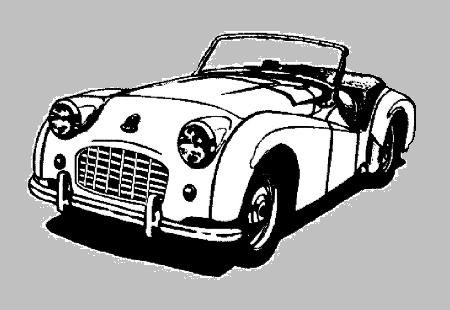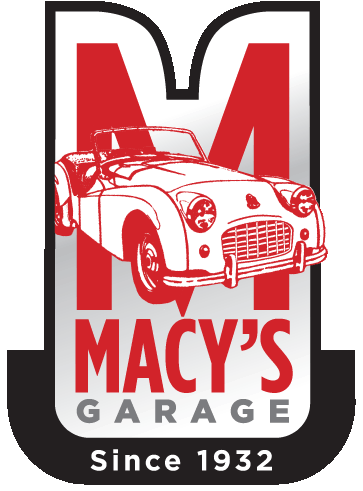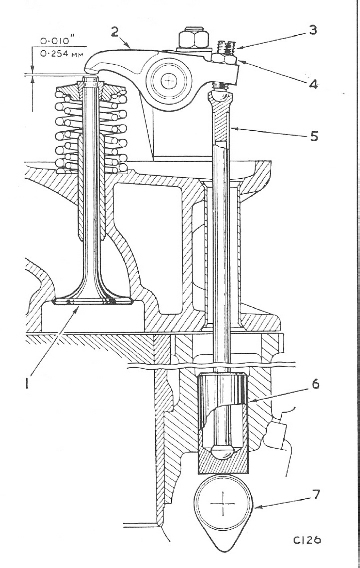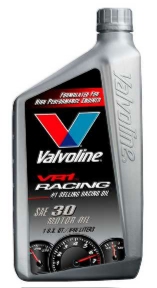
 ZDDP Oil Additive
ZDDP Oil Additive
|
Macy's Garage, Ltd. America's BEST Triumph Shop! |
ZDDP and Me
It’s been all over the automotive blogs, chat rooms, discussion groups, and print publications for the past few years. The EPA has forced the reduction or elimination of ZDDP (Zinc Dialkyl-Dithio-Phosphate) from engine oil. Are there consequences for owners of vintage autos, and our Triumphs in particular, or is this just the latest version of ‘the sky is falling’?
 Motor oil is one of
those HOT buttons that is always capable of starting a debate among car guys.
Most gear heads have a particular brand of oil that they feel is the best, and
will debate the merits at length with anyone who doesn’t concur with their
opinion. But this latest debate among vintage car folks over ZDDP is widespread and touches everyone addicted to motors designed more
than 20 years ago. You see, for most of the last century, the almost
universal method to open and close engine valves was via flat tappets (solid
or hydraulic lifters if you will), and the ZDDP additive was there to prevent
or reduce wear between the lifters and the camshaft (#6 and #7
respectively in the diagram to the right). But ZDDP in the minute
amounts of oil that will get burned and exit through the exhaust system will
shorten the life of catalytic converters. Thus the EPA mandate to eliminate
ZDDP from engine oil, and the auto makers have responded by designing engines
that utilize roller lifters or overhead camshafts, and have no need for the
protection offered by ZDDP.
Motor oil is one of
those HOT buttons that is always capable of starting a debate among car guys.
Most gear heads have a particular brand of oil that they feel is the best, and
will debate the merits at length with anyone who doesn’t concur with their
opinion. But this latest debate among vintage car folks over ZDDP is widespread and touches everyone addicted to motors designed more
than 20 years ago. You see, for most of the last century, the almost
universal method to open and close engine valves was via flat tappets (solid
or hydraulic lifters if you will), and the ZDDP additive was there to prevent
or reduce wear between the lifters and the camshaft (#6 and #7
respectively in the diagram to the right). But ZDDP in the minute
amounts of oil that will get burned and exit through the exhaust system will
shorten the life of catalytic converters. Thus the EPA mandate to eliminate
ZDDP from engine oil, and the auto makers have responded by designing engines
that utilize roller lifters or overhead camshafts, and have no need for the
protection offered by ZDDP.
Motor oil has carried a performance rating from the American Petrolium Institute (API) since the days of horseless carriages. Pick up any quality motor oil at your local auto parts store, and you’ll see the API logo on the bottle. (I grew up with oil cans, and I’m still having trouble getting used to this oil ‘bottle’ thing!) Automobile oils have a two letter service designation, which always begins with the letter “S”, and then works its way down the alphabet for the second letter. Historically, the newest designations have always met the performance specifications of the previous ones, and so there was never an issue with using the latest technology motor oil in vintage autos, until now. While ZDDP levels have been gradually reduced starting with SG oils in 1988, it is the latest SM designated oil with the nearly total elimination of ZDDP has raised the concerns of all vintage auto enthusiasts who fear the worst for their cams and lifters.
Now I have to admit that I was skeptical of all this doom and gloom talk at first. Then as I’ve learned more about just what ZDDP is, and what it’s supposed to do, I remembered some Triumph engine problems that have been discussed over the past few years. The problems, which have been reported by several different individuals, concerns the rapid wear and almost total destruction of the camshaft and lifters in freshly overhauled engines. Up to now, this problem has been blamed on ‘reproduction’ lifters (tappets) which are too ‘soft’ when tested on a Rockwell hardness tester. But now I’m starting to believe that this might have been the first appearance of a lubrication problem, and the new reproduction parts were the quickest and easiest place to lay the blame. Since the benefits of ZDDP are especially important during the break-in period for camshafts and lifters, it makes sense to me that the excessive wear and destruction of parts will show up in recently overhauled engines well before we see it in higher mileage motors.
So now that I’m starting to believe that this ZDDP thing could be a real problem, what can we do about it? There have been a number of possible “fixes” suggested already, but deciding on the best one is going to fall back on personal taste, providing even more fodder for oily discussions among motor heads. One quick solution that’s been suggested is to use a diesel motor oil that contains enough ZDDP to fend off the premature cam & lifter wear. But diesel motor oils carry completely different API ratings which begin with the letter “C”, and they also contain additive packs which were designed for the diesel’s unique characteristics, and may not be totally appropriate for use in gasoline engines. You also can't automatically assume that just any diesel oil contains enough ZDDP to provide adequate protection. To me, this is almost as scary as running my Triumphs without the ZDDP additive, so personally I won’t even consider this as an option.
In the wake of all the fears over potential engine damage, oil supplements containing ZDDP are going to start showing up in catalogs and store shelves in a big way. Each will claim to have just what your car needs, and only time will tell if they solve the problem or amount to nothing more than modern day snake oil. Without a performance rating system such as the API designations for oil, there is really no way to substantiate the claims of the manufacturers’ marketing departments until your engine lives another 10,000 miles or so without self destructing. I’m not willing to let my TR motors be the experimental test bed for these additives, but please be sure to let me know how it all works out in yours!
Another option is the specialty oils for classic and vintage cars that are starting to appear on the market. All of these I've seen so far list ZDDP as an ingredient, but they all appear to be available only in multi-grade weights (viscosity) such as 10W-30 and 20W-50 so far. While this is going to be fine in engines of the mid 1960's - 1980's, I haven't had the best luck using them in engines from earlier times when the factory recommendations were for single weight oils.
The fourth and final option, and the one that I’ve decided to pursue, is to find some single weight gasoline engine oil that still contains adequate levels of ZDDP and meets an earlier API rating than SM. You’re probably not going to walk into the nearest Auto Zone or Pep Boys and find this oil on the shelf, but it is still available if you do a little bit of digging. You should also know that the days of buying your TR oil for under $3.00 a quart are over, but the $5 something it will cost is no different than buying the ‘cheap’ oil and adding a $10 supplement to it. (Here’s another one I’m having trouble with, because I can still remember selling oil for $0.30 a quart, and that included the tax!)
I did a quick search on the NAPA auto parts web site (www.napaonline.com), and with a little luck I found that I could search the engine oils by API ratings, brand, or by weight. You have to get pretty deep into the web site before this becomes available, so I’ll give you a road map to find it. From the NAPA home page, select browse PartsPRO SE Catalog. Then every time you see “Browse by Category”, select the following options in this order; Chemicals & Car Care Products, Oil Grease & Lubricants, Motor Oil – 1Qt/1Liter Universal. From there you’ll be able to search for an appropriate vintage car motor oil, and read all of the specs associated with it.
 I was delighted to find that for the straight 30W and 40W
oils that I use in my Triumphs (and as recommended by the factory manuals), NAPA
still carries SL, SJ, and SH oils in their own NAPA brand, as well as from
Pennzoil, Quaker State, and Valvoline. You’ll have to get the part numbers from
the web site and then have your local NAPA store order a full case (12 qt) for
you, but the peace of mind will more than make up for the small effort required
to obtain it.
I was delighted to find that for the straight 30W and 40W
oils that I use in my Triumphs (and as recommended by the factory manuals), NAPA
still carries SL, SJ, and SH oils in their own NAPA brand, as well as from
Pennzoil, Quaker State, and Valvoline. You’ll have to get the part numbers from
the web site and then have your local NAPA store order a full case (12 qt) for
you, but the peace of mind will more than make up for the small effort required
to obtain it.
I’ve been a Valvoline guy for nearly 40 years now, so I was happy to find their VR1 racing oil with SL, SJ, SH ratings available from NAPA in both SAE30W and SAE40W, and I ordered a case of 30W. When I picked it up from my local NAPA store, I was extremely happy to see “ZDDP additive provides tough anti-wear protection” on the outside of the case, and a similar statement on each bottle. While this issue and the debate it has caused is far from over, I can rest easier knowing that a solution I’m comfortable with is still available, at least for now.
UPDATE 5/12/2008: The confusion on this topic continues and as predicted, the debate rages on. While I did write this article based upon several published sources, more information has since surfaced which clouds the issue just a bit more. A call to the Valvoline tech line shown on all of their oil bottles, and a discussion with a Valvoline engineer, revealed that the API designations do not necessarily tell the whole story on the ZDDP content of the oil. Some SM oils will still contain some ZDDP, and some of the earlier designations may not contain enough to protect our early design engines. So the bottom line is that you should use the API ratings as a starting point in your search, and then if the oil bottle does not specifically mention ZDDP and the protection it provides for camshafts and lifters, place a call to the tech line shown on most bottles and confirm that you are getting what you think you are!











